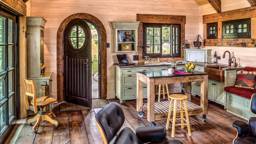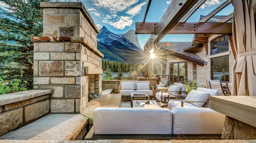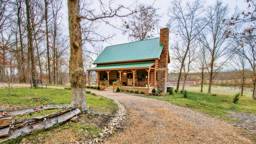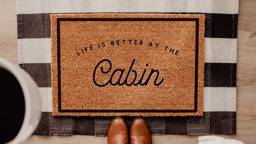Built-ins
Built-in furniture makes the most efficient use of space. These custom-crafted units fit a nook to a T. Since built-ins are made to measure, they are costlier than freestanding pieces. But they’re a godsend for smaller cabins. Just ask Phil Regan, principal at Mark Hutker Associates Architects in Vineyard Haven, Mass.
On the picturesque island of Martha’s Vineyard – where regulations limit the scale of construction and fabulous views dictate more glass, less wall – Regan relies on built-ins to meet homeowners’ requirements. His cabinets, window seats and box beds are designed as part of the architecture. “Built-in furniture is there for good. You don’t take it with you. It cuts down on waste. Living on an island, we’re concerned about the debris that we have to do away with. We look hard at how we use and reuse.”
Shipshape built-ins perform more than one function. Incorp-orating drawers, bookshelves and other features takes full advantage of a nook’s potential for sitting, sleeping and storage. Regan was even able to shoehorn a second bedroom – bed, dresser and desk – onto a landing in one Vineyard cottage using built-ins. In a tight radius, he says, round off corners to avoid “hip-bangers.” Take your inspiration from a boat’s cabin, suggests Regan. “It doesn’t matter what your budget is or how small the project is if you approach it with creativity.”
Built-in furniture makes the most efficient use of space. These custom-crafted units fit a nook to a T. Since built-ins are made to measure, they are costlier than freestanding pieces. But they’re a godsend for smaller cabins. Just ask Phil Regan, principal at Mark Hutker Associates Architects in Vineyard Haven, Mass.
On the picturesque island of Martha’s Vineyard – where regulations limit the scale of construction and fabulous views dictate more glass, less wall – Regan relies on built-ins to meet homeowners’ requirements. His cabinets, window seats and box beds are designed as part of the architecture. “Built-in furniture is there for good. You don’t take it with you. It cuts down on waste. Living on an island, we’re concerned about the debris that we have to do away with. We look hard at how we use and reuse.”
Shipshape built-ins perform more than one function. Incorp-orating drawers, bookshelves and other features takes full advantage of a nook’s potential for sitting, sleeping and storage. Regan was even able to shoehorn a second bedroom – bed, dresser and desk – onto a landing in one Vineyard cottage using built-ins. In a tight radius, he says, round off corners to avoid “hip-bangers.” Take your inspiration from a boat’s cabin, suggests Regan. “It doesn’t matter what your budget is or how small the project is if you approach it with creativity.”
Bays and Bows
Nooks can blur the line between inside and outside. “Most humans like to feel closer to nature, but not unprotected,” says Schafer. A bay or bow window creates a beautiful enclosure. Not only do these projecting windows brighten a room and capture summer breezes, they offer a 180-degree view. Bay units come with glass on three planes: a fixed picture window in the middle and two angled side windows that open as double-hung or casements (the latter are more energy efficient; choose low-e glass to reduce fading). The angles can be acute (30, 45 or 60 degrees) or right (90 degrees), depending on the look you’re after.
Bow windows have a curved shape created by four or more windows mulled together in the factory. Since more windows are used, bow units cost more than bays. Installing a bay window at counter height in a kitchen creates a mini-greenhouse. Drop the sill to waist height for a banquette, or lower it to the floor for a dining nook. A bumped-out bay or bow creates extra space in any room, and more economically than adding a sunroom.
Finding your Niche
Where’s the best place to create a nook? First, scope out your cabin’s hidden assets. Ask yourself which rooms get the most light at different times of the day, and in different seasons. Which have the most wall or floor space, the highest ceilings? Which are the quietest or most underused?
After you weigh your cabin’s potential, assess it in terms of lifestyle. Be specific about the function(s) of your intended nook. Do you want to emphasize the view with a window seat or bay? Would you like a sanctuary in which to read or exercise? More guest accommodation? Somewhere to play games, indulge a hobby, write postcards? Storage or display shelves? Do you need closets to hang clothes if you only weekend at the cabin, or could you borrow that space for something else?
Window seats are wonderful in any room of the cabin. Again, consider location and function. Do you want sun with your morning coffee? Will a southern or western exposure be too hot or bright for reading? If it’s just for sitting, the seat can be 18 inches or less in depth. For napping, make it at least 3 feet deep and 5 feet wide. Let the room dictate what you store underneath – bedding, toys, picnic supplies, etc.
A bed under the eaves makes a cozy retreat, and vaulted ceilings in a bedroom are ideal for bunk beds. In a low-ceilinged bedroom, built-in bunk beds can be stacked like train compartments, each with its own light and curtain.
Schafer’s clients often request small kitchen extensions that may incorporate a breakfast or serving bar with stools on one side, and a drop-down table on the other. Often these nooks have access to a deck so guests can amble in, help themselves to the buffet and wander back outside.
Nooks can be outdoor spaces too, observes architect Mira Jean Steinbrecher: a sleeping pavilion, a summer sleeping porch, a gazebo or just a sunny spot in the crook of a cabin. In the Southwest, it could be an inner courtyard or a little café table that faces east for breakfast. “I have a cupboard porch where I eat three meals a day,” says Stein-brecher, who lives in a cottage on Whidbey Island, Wash.
A Sense of Scale
Furnishing a nook can complement a cabin’s architecture by incorporating existing details, or add visual interest where detail is lacking. “It’s a question of scale and appropriateness,” continues Steinbrecher, who cautions against mixing overly large or rustic furnishings with delicate, refined pieces.
“Scale of space is everything,” concurs Regan. “I can draw a 4,000-square-foot home and have it perceived as monstrous. Or small. Bigger is not better. Quality is more rewarding.”
Spend the money on details that you touch and feel every day and that make you feel at home, Regan advises. “In the long run, you’ll have an heirloom worthy of preservation for your children and grandchildren.”
Frances Sigurdsson desperately needs nooks for more houseguests at her lakeside home in the Adirondacks.
Nooks can blur the line between inside and outside. “Most humans like to feel closer to nature, but not unprotected,” says Schafer. A bay or bow window creates a beautiful enclosure. Not only do these projecting windows brighten a room and capture summer breezes, they offer a 180-degree view. Bay units come with glass on three planes: a fixed picture window in the middle and two angled side windows that open as double-hung or casements (the latter are more energy efficient; choose low-e glass to reduce fading). The angles can be acute (30, 45 or 60 degrees) or right (90 degrees), depending on the look you’re after.
Bow windows have a curved shape created by four or more windows mulled together in the factory. Since more windows are used, bow units cost more than bays. Installing a bay window at counter height in a kitchen creates a mini-greenhouse. Drop the sill to waist height for a banquette, or lower it to the floor for a dining nook. A bumped-out bay or bow creates extra space in any room, and more economically than adding a sunroom.
Finding your Niche
Where’s the best place to create a nook? First, scope out your cabin’s hidden assets. Ask yourself which rooms get the most light at different times of the day, and in different seasons. Which have the most wall or floor space, the highest ceilings? Which are the quietest or most underused?
After you weigh your cabin’s potential, assess it in terms of lifestyle. Be specific about the function(s) of your intended nook. Do you want to emphasize the view with a window seat or bay? Would you like a sanctuary in which to read or exercise? More guest accommodation? Somewhere to play games, indulge a hobby, write postcards? Storage or display shelves? Do you need closets to hang clothes if you only weekend at the cabin, or could you borrow that space for something else?
Window seats are wonderful in any room of the cabin. Again, consider location and function. Do you want sun with your morning coffee? Will a southern or western exposure be too hot or bright for reading? If it’s just for sitting, the seat can be 18 inches or less in depth. For napping, make it at least 3 feet deep and 5 feet wide. Let the room dictate what you store underneath – bedding, toys, picnic supplies, etc.
A bed under the eaves makes a cozy retreat, and vaulted ceilings in a bedroom are ideal for bunk beds. In a low-ceilinged bedroom, built-in bunk beds can be stacked like train compartments, each with its own light and curtain.
Schafer’s clients often request small kitchen extensions that may incorporate a breakfast or serving bar with stools on one side, and a drop-down table on the other. Often these nooks have access to a deck so guests can amble in, help themselves to the buffet and wander back outside.
Nooks can be outdoor spaces too, observes architect Mira Jean Steinbrecher: a sleeping pavilion, a summer sleeping porch, a gazebo or just a sunny spot in the crook of a cabin. In the Southwest, it could be an inner courtyard or a little café table that faces east for breakfast. “I have a cupboard porch where I eat three meals a day,” says Stein-brecher, who lives in a cottage on Whidbey Island, Wash.
A Sense of Scale
Furnishing a nook can complement a cabin’s architecture by incorporating existing details, or add visual interest where detail is lacking. “It’s a question of scale and appropriateness,” continues Steinbrecher, who cautions against mixing overly large or rustic furnishings with delicate, refined pieces.
“Scale of space is everything,” concurs Regan. “I can draw a 4,000-square-foot home and have it perceived as monstrous. Or small. Bigger is not better. Quality is more rewarding.”
Spend the money on details that you touch and feel every day and that make you feel at home, Regan advises. “In the long run, you’ll have an heirloom worthy of preservation for your children and grandchildren.”
Frances Sigurdsson desperately needs nooks for more houseguests at her lakeside home in the Adirondacks.
HERE A NOOK THERE A NOOK
Where can you create a nook? Possibilities abound:
• Entries, halls and landings are often good candidates. A comfortable chair or daybed can give you reason to pause in these transition areas.
• The space under stairs offers a host of possibilities. Reconfigure it for a half-bath, a stacked washer/ dryer, storage cubbies – even a pint-size kitchen.
• Tuck in a roll-top writing or fly-tying desk beneath an open stairway.
• Don’t let recessed areas on either side of a fireplace or chimney off the hook.
• If you have an open-plan layout, consider half walls, log columns, interior windows, or lowered ceilings as a way to demarcate zones and add architectural interest.
• Folding floor screens can define nooks (and hide clutter), with the advantage that you can move them to open up the space as needed.
BAYS & BOWS
Architect Mira Jean Steinbrecher finds bay and bow windows charming. If you’re considering a bay or a bow, here are some tips from this pro:
• If the space projects more than a couple of feet, it needs a foundation.
• If the window is cantilevered without a foundation, the space can be cold because of all the glass.
• Think about which way the sun comes in or you might wind up with a very hot space.
• Think about light. If you install one facing north you may have a great view, but you won’t get much light. If the window on your lakeside cabin faces west, you might have to pull the blinds to avoid bright rays bouncing off the water.
Resources:
Steinbrecher specializes in log and timber frame design, www.jeansteinbrecher.com.
For more info on bays and bows, consult window companies such as Andersen Windows, www.andersenwindows.com or Marvin Windows, www.marvin.com.
Architect Mira Jean Steinbrecher finds bay and bow windows charming. If you’re considering a bay or a bow, here are some tips from this pro:
• If the space projects more than a couple of feet, it needs a foundation.
• If the window is cantilevered without a foundation, the space can be cold because of all the glass.
• Think about which way the sun comes in or you might wind up with a very hot space.
• Think about light. If you install one facing north you may have a great view, but you won’t get much light. If the window on your lakeside cabin faces west, you might have to pull the blinds to avoid bright rays bouncing off the water.
Resources:
Steinbrecher specializes in log and timber frame design, www.jeansteinbrecher.com.
For more info on bays and bows, consult window companies such as Andersen Windows, www.andersenwindows.com or Marvin Windows, www.marvin.com.
A Room of One’s Own
Be honest. Family gatherings at the cabin are fun, but can sometimes try the soul. When the place is bursting at the seams or rain has everyone cooped up, nooks coax you to slip away for time to yourself. A reading nook off the master bedroom fit the bill for an Edgewood log homeowner in Idaho. The 7-by-8-foot nook, accessible through a log archway, features a built-in daybed with shelving below. Windows extend down to the bed. “The lady of the house wanted a quiet corner,” says Brian Schafer, president of Edgewood Log Structures in Coeur d’Alene, Idaho. “She can enjoy views in both directions.”
A growing trend is towers that command territorial views on all four sides. While not technically a nook, they do provide the same type of serenity and sense of personal space. Reminiscent of old fire or storm watchtowers, they let you experience the elements from the safety of the cabin. Of course, towers make superior guest bedrooms and stargazing aeries as well as weather and wildlife observation posts.
Be honest. Family gatherings at the cabin are fun, but can sometimes try the soul. When the place is bursting at the seams or rain has everyone cooped up, nooks coax you to slip away for time to yourself. A reading nook off the master bedroom fit the bill for an Edgewood log homeowner in Idaho. The 7-by-8-foot nook, accessible through a log archway, features a built-in daybed with shelving below. Windows extend down to the bed. “The lady of the house wanted a quiet corner,” says Brian Schafer, president of Edgewood Log Structures in Coeur d’Alene, Idaho. “She can enjoy views in both directions.”
A growing trend is towers that command territorial views on all four sides. While not technically a nook, they do provide the same type of serenity and sense of personal space. Reminiscent of old fire or storm watchtowers, they let you experience the elements from the safety of the cabin. Of course, towers make superior guest bedrooms and stargazing aeries as well as weather and wildlife observation posts.
A cabin can never have too many nooks and crannies. Picture an inglenook with bookshelves and bench beside a crackling fire. A sleeping loft. A sunny window seat or breakfast nook. Cozy spots like these entice children and adults alike. Toss in a spectacular view, and they’re irresistible.
Little nooks are big on practicality, too. Need more elbow room? Nooks press every square inch of the cabin into service. Suddenly, that odd recess goes from wasted space to functional niche. In tight spots, nooks lead double lives. An extended window seat moonlights as a guest berth. A banquette conceals tableware. Shelving becomes a room divider. The result: multitasking rooms zoned for different activities.
Not only do nooks maximize living space, they can make a tiny cottage seem larger and a great lodge more cozy.
In a small cottage, fitting kitchen appliances in a corner frees up the center for socializing. Conversely, nooks create an intimate space within a lodge’s great room. Just arrange furniture in groupings no more than 6 feet by 6 feet – large enough for two to chat or collaborate on a jigsaw puzzle. That way, the whole clan can be together even when doing different things.
Little nooks are big on practicality, too. Need more elbow room? Nooks press every square inch of the cabin into service. Suddenly, that odd recess goes from wasted space to functional niche. In tight spots, nooks lead double lives. An extended window seat moonlights as a guest berth. A banquette conceals tableware. Shelving becomes a room divider. The result: multitasking rooms zoned for different activities.
Not only do nooks maximize living space, they can make a tiny cottage seem larger and a great lodge more cozy.
In a small cottage, fitting kitchen appliances in a corner frees up the center for socializing. Conversely, nooks create an intimate space within a lodge’s great room. Just arrange furniture in groupings no more than 6 feet by 6 feet – large enough for two to chat or collaborate on a jigsaw puzzle. That way, the whole clan can be together even when doing different things.














